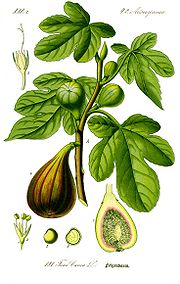
Syconium
Encyclopedia

Fruit
In broad terms, a fruit is a structure of a plant that contains its seeds.The term has different meanings dependent on context. In non-technical usage, such as food preparation, fruit normally means the fleshy seed-associated structures of certain plants that are sweet and edible in the raw state,...
borne by figs (genus Ficus
Ficus
Ficus is a genus of about 850 species of woody trees, shrubs, vines, epiphytes, and hemiepiphyte in the family Moraceae. Collectively known as fig trees or figs, they are native throughout the tropics with a few species extending into the semi-warm temperate zone. The Common Fig Ficus is a genus of...
), formed of an enlarged, fleshy, hollow receptacle with multiple ovaries
Ovary (plants)
In the flowering plants, an ovary is a part of the female reproductive organ of the flower or gynoecium. Specifically, it is the part of the pistil which holds the ovule and is located above or below or at the point of connection with the base of the petals and sepals...
on the inside surface. In essence, it is really a fleshy stem with a number of flowers, so it is considered both a multiple
Multiple fruit
Multiple fruits are fruits that are formed from a cluster of flowers . Each flower in the inflorescence produces a fruit, but these mature into a single mass...
and accessory
Accessory fruit
An accessory fruit is a fruit in which some of the flesh is derived not from the ovary but from some adjacent tissue exterior to the carpel. Examples of accessory tissue are the receptacle of strawberries, figs, or mulberries, and the calyx of Gaultheria procumbens or Syzygium jambos...
fruit. The name comes from the Greek word sykon, meaning "fig".

